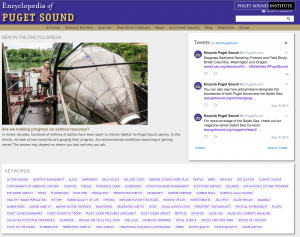
These days, you may know the Encyclopedia of Puget Sound as a news source. Our magazine stories and blogs cover science as it happens across the Salish Sea, from research on salmon recovery to toxic chemicals in the food web.
There is no other publication focusing strictly on Puget Sound science, and — we’ll be bold here — we strive to provide the best such coverage in the region. Not because we have the most stories or the biggest staff (we don’t), but because we report the news that you need to know.
We work closely with the scientists on the ground and often hear what’s happening before the major media outlets. We work hard to get the stories right, and we provide context that other publications can’t.
That context is one of the most important parts of the Encyclopedia of Puget Sound. We are a news source, but we are also a resource — an encyclopedia. If you want to know how scientists and policymakers view the ecosystem and how they are working to protect it, we have organized it from A to Z.
This August, as the dog days settle over Puget Sound and forest fires rage in the distance, we’ll continue to build the encyclopedia behind the scenes. Do you want to know more about toxic algae blooms or zooplankton? How about floodplains or the impacts of shoreline armoring? There’s plenty to discover. You can use the encyclopedia in your classes. Share it with policymakers. Identify thousands of species. Find out the age of a rock fish. Scope out local beaches. The website continues to get better every day, and we are glad to bring it to you.